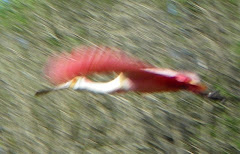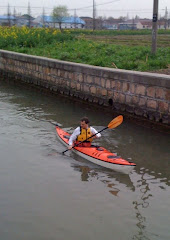
What can you say when someone asks if you fancy joining them at Deception Pass for a spin in a kayak? It's a fun place to play after a full moon and it's a sunny fall day with the trees in blazing colors. Sadly I'm effectively grounded from the water this month so I had to decline Nacho's invitation. Nacho is one of a growing group of people who, although he doesn't burn his food, does burn the cooking oil afterwards. His diesel Mercedes is converted to run on vegetable oil and other similar natural fats, leaving behind it a slightly confusing "restaurant" scent and nothing much in the way of pollutants. For me that's a huge plus.
From San Diego, Nacho has spent his summers in Alaska as a park warden, migrating north and south with the seasons with a trunk laden with drums of dirty cooking oil. Collecting the oil solves the disposal problems for restaurants on the route, and leaves Nacho with the mouth-watering task of filtering out a residue of fries before filling his tank instead of inhaling benzine beside the pump. He stopped by on his way north last year to say "Hi!" to grab a snack, and to top up his tank... that's him in Seattle in the photo...
Last week I was in Shanghai breathing the hazy air of a city with a population, including migrant workers, conservatively estimated to exceed 20 million. Not everybody there drives a car, but the air is distinctly "heavy" to breath, and that's air that travels east... toward USA. I know the Chinese use cooking oil... for cooking... but what do they do with it afterwards? Perhaps there's a place for some education... after all, the Chinese do have the only cities I know of that have banned two-stroke motor-scooter engines in favor of electric scooters in the quest for cleaner air.
Nacho is giving talks about bio-diesel at a few colleges on his way south this time. He'll be in Seattle in a day or two. He does have a blog: check it out! In the meantime you can see him on my web-site, in the Misty Fjords, SE Alaska, where he turned up unexpectedly at our camp site in the middle of nowhere bearing the gift of dressed crab and fresh salad!
































